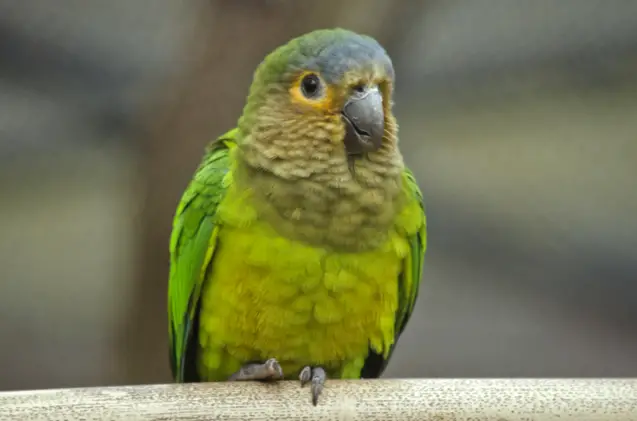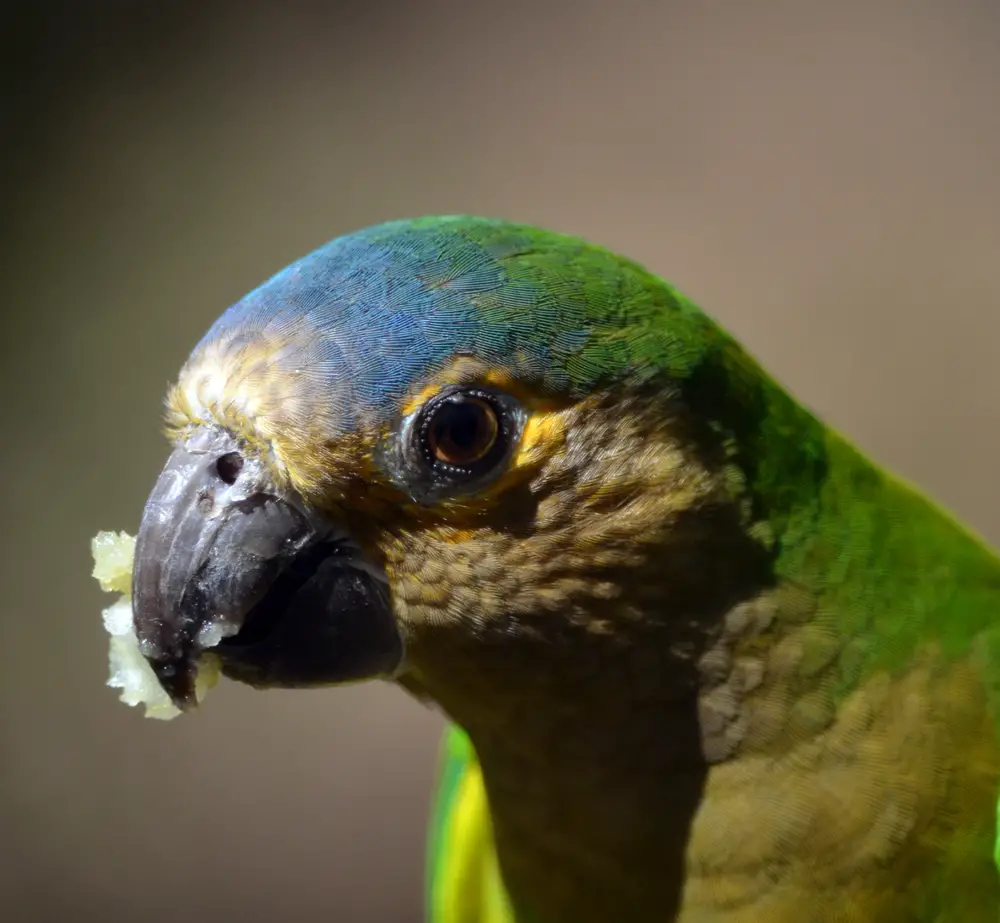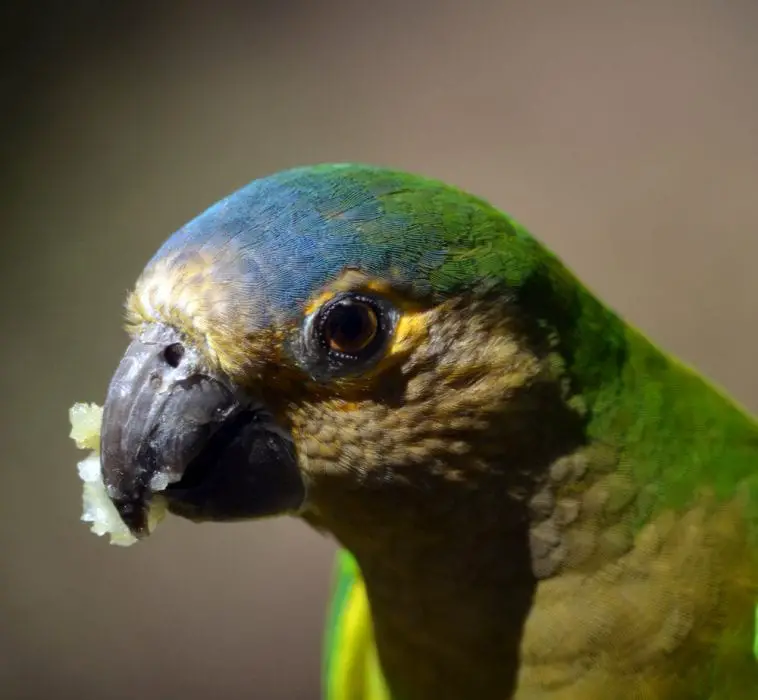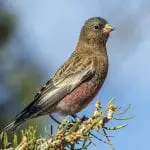Scientific Facts
| Common Name: | Brown-throated conure |
| Scientific Name: | Eupsittula pertinax |
| Life Span: | Up to 25 years |
| Size: | 10 inches |
| Habitat: | Woodlands, savannas, scrub, and dense forests |
| Country of Origin: | South America, Venezuela, Guianas, Colombia, and Brazil |
Physical Description

This bird is one of the rarest conures as of now. The brown-throated conure is surprisingly charming and can turn into a wonderful pet. With its cute looks and a goofy and sociable personality, this bird never fails to make a person smile by just looking at it as it does some tricks. As a highly sociable bird, it will usually make a strong relationship with its owners. It requires more time for interacting and playing with humans.
Besides, it does not ask for more in terms of maintenance. Therefore, the brown-throated conure is a good choice of pet for novices and people who might be searching for a loving and friendly parrot. The fame of this bird as a pet proves its lovable traits.
The brown-throated conure is mostly 25 centimeters or 10 inches long. Its plumage is almost pure green. Its forehead, chin, and the sides of its head are yellowish-orange. The bird’s crown is blue while the upper breast and throat are light olive-brown. Its lower breast is yellowish-green while the abdomen is orange.
Moreover, the bird’s underwing coverts are also yellowish-green, but the endings of the longest feathers on the wing are blue. The external webs of the secondaries or the shorter feathers of the upper arm are blue while the underside of its wings and tails are olive-yellow.
The brown-throated conure also has a white periophthalmic ring with yellow irises. The beak of this bird is black while the feet are greyish. Young brown-throated conures have horn-colored upper bill and brownish cheeks. Their upper breast and throat are greenish.
Personality
As among the friendliest conures, the brown-throated conure comes with a fun and loving personality. Its energetic nature is making it more inclined to goof off and be silly. Therefore, you can always expect to learn new tricks. Still, the bird likes scratches and cuddles. This bird is so affectionate to humans.
You will be happy while watching its small feet and how silly the bird walks. You will be pleased with its hilarious behavior, too. The brown-throated conure is an excellent pet for families, singles, and seniors. Everybody will appreciate its sweet, entertaining nature.
The brown-throated conure and its associated subspecies are clever birds that have the amazing ability to speak. However, just like other parrot species, there’s no assurance that a bird can learn to speak. This animal usually turns into highly affectionate pets, given that it is well-socialized and properly handled. The brown-throated conure tends to prefer a family member instead of bonding with everyone in the house.
This bird might be so loud and develop destructive behaviors. It needs to have more toys to keep it less vulnerable to boredom. The brown-throated conure lives for up to 10 years in most cases. With proper care, the bird can live for up to 25 years, though.
Natural Habitat
The brown-throated conure is more common in northern South America. It also exists in Venezuela, Guianas, Brazil, Colombia, and the Leeward Antilles. These regions where this bird can be found guarantees its stable population, making this bird existing in aviculture. Its favorite nesting spot is the termite mound that is more common in trees. It’s among the unique cases of nesting habits within the world of parrots.
Sounds and Speech
There’s a big difference in the level of noise associated with the brown-throated conure and other conures, such as the Nanday and Sun conures. This bird is still vocal, yet it tends to be quieter than those conure species that make it a more suitable pet bird for those who live in apartments.
The brown-throated conure has a cute voice, and it can make melodious calls that you will hear now and then. The bird, however, becomes loud and noisy when it is neglected, lonely, or bored. However, in general, it turns to be a very apartment-friendly pet.
Colors
This bird has simple colors, earthy tones, and fewer details compared to other conures. These things are making this bird a simple and charming pet. Its coloring works well with the quirky and cute looks that make it even more adorable.
Its body is bright green while the abdomen and chest areas are in a lighter shade of yellow. The bird’s throat and cheeks are brownish-green – a detail which gives it the name. The black bill and small but cute feet make the bird good-looking in general. These features are giving this animal an iconic and irresistible look.
Feeding

In the forest, this parrot sustains itself with a variety of foods. Its diet consists of just the basics such as nectar, fruits, seeds, insects, and crops. A commercial mix of seeds for conures will be good for your pet. It is rich in minerals that are more common on rye, oats, maize, or millet seeds. To supplement its diet, you must add a few fresh veggies and fruits. Occasionally, you can give it with cooked food such as potato and chicken breast. It assures your pet is less susceptible to vitamin deficiencies that may lead to feather-associated issues or chemical imbalances.
Common Health Problems Associated with the Brown-throated Conure
Do not allow its fragile look, and the small size of this parrot fool you. The brown-throated conure is incredibly strong and immune to diseases. At the same time, it is so adaptable. Ensure your pet has a well-balanced diet, more exercise, more time for socializing. All these things will help a lot in keeping your pet happy and healthy.
Housing
The brown-throated conure is not so active like other conures, but this one requires more space inside its cage for its toys. The minimum size of the cage made for a brown-throated conure is 18 inches long, 18 inches wide, and 24 inches tall.
The bigger the housing, the more comfortable this will be for the animal. A good enclosure must have horizontal bars on two sides. A conure is an acrobatic animal that loves climbing. The horizontal bars will help your bird climb with ease. The bar spacing must not be over 3 ¼ inches apart that will help prevent injuries to your pet.
You can keep this conure at room temperature. Make sure the bird and the cage are off the ground and apart from drafty or hot places like air vents, open windows, and doorways. Tropical areas have a daytime temperature of around 70 degrees Fahrenheit and are not lower than 65 degrees Fahrenheit at night.
Due to this, the parrot kept constantly at a temperature lower than 65 degrees Fahrenheit is often stressed. Stress is not good for your pet as it wears down its immune system and triggers it to catch drafting. Another crucial thing to keep in mind is that the brown-throated conure is more susceptible to draft when left wet.
When the room where the bird is living is 65 degrees Fahrenheit, it must be set to a warmer spot to dry after taking a bath. The bird that habitually bathes in the water must stay in a warmer room temperature of 70 degrees Fahrenheit or higher in all cases.
The cage of the conure must have 2 to 3 perches of different shapes, sizes, and textures, so the feet stay strong and healthy. Be sure the perches are dense enough for your pet so that it can stand comfortably without losing the balance.
For the brown-throated conure, it’s typically between 1 ¼ inch in diameter. Certain materials to have in mind are the natural wooden branches such as concrete, bonded, pumice sand perches, including rope perches.
Any bird, regardless of the size, must-have toys inside its cage to avoid boredom. The brown-throated conure is a destructive bird that requires more toys that it can chew to stay occupied. Parrots need these things to keep themselves distracted as they tend to be so intelligent. In the forest, these birds solve many problems every day to find food, make nesting sites, or avoid predators.
Give your pet at least 3 toys made of various materials kept inside the cage. All these toys must be suitable for chewing, which is a crucial part of the bird’s beak healthy. These toys can be made of acrylic or plastic and some materials or a combination of excellent materials like sisal rope, veggie-tanned leather, wooden palm leaves, and corn cob.
When your bird is kept in a noise-free room, you might like to obtain a cover for its enclosure to help it fall asleep with ease at night. In many tropical regions, the number of daylight hours stays constant across the year. Your bird requires a constant 10 to 12 hours of rest and sleep in the evening to stay healthy.
When your bird lives in active rooms, it would be kept awake by low sounds and would not get the ideal rest it needs. For that case, you might want to obtain a smaller case for the bird to sleep and put it in a silent room like the home office or guest room. By using a smaller cage, your pet will stay in a quiet place to have a pleasing night’s sleep.
Hygiene and Grooming
The bird likes to bathe. However, different birds choose to take a bath in various ways. Some of them want to take a bath in shallow dishes while others like being sprayed with fine mists. Other birds find taking a shower with their owners a much more enjoyable experience. Since most birds are from those areas that are getting more rainfalls, it is so important to allow them to get wet each day provided that their health stays in good condition.
Clipping and trimming the flight feathers of your pet is unimportant, but this will help in getting your bird well-tamed. Also, this will help in preventing injury and escape. Birds such as the parrots can’t survive in the weather in most parts of the United States. It will not survive with no flocks. The nails can be cut by a qualified individual when they grow unhealthy, too long, and stop the bird from moving.
Maintenance
You must wipe down its cage, toys, and perches every day by using soapy water. Replace the used paper in its tray. Make use of the non-toxic cleaner like a gentle dishwashing liquid.
Also, be sure that you completely rinse the soap. Disinfect the perches and cage by using bleach water while keeping your pet in a different room.
Also, you must rotate the toys once your pet loses interest in these items. Do it more often as the brown-throated conure loves to chew and tends to be so destructive with its toys.
Where to Get One?
The brown-throated conure is widely available in the local and online pet stores. You may also get this bird from the local breeders out there that are specializing in breeding and raising conures. To get the best experience in taking care of a brown-throated conure, always make sure your pet will come from a reliable source. Likewise, don’t forget to check the bird’s health before taking the animal.
How to Care for a Brown-Throated Conure?
A brown-throated conure is a fun, sociable, and loving pet. Taking care of it is not a big challenge. Even the first-time bird keepers will enjoy having this animal as a pet. Just a well-balanced diet, plenty of exercise and playtime are enough to keep a brown-throated conure healthy and active.
FAQs
Is a brown-throated conure a noisy pet?
Conures are known to be silly and sociable, but some of them tend to be less noisy than others, such as the brown-throated conure. It may make sounds and calls for some time, but it stays silent most of the time.
Does the brown-throated conure love being held?
Conures are lovable pets. The brown-throated conure is friendly and affectionate as it loves to be with its favorite person, though it can be friendly as well to other family members.
How long does the brown-throated conure grow?
This little parrot grows up to 10 inches. It has a long tail that makes up for its size.
Is a brown-throated conure ideal for apartment occupants?
The brown-throated conure tends to be less noisy than other conures. Hence, it can be a great pet of choice for those who live in apartments.



